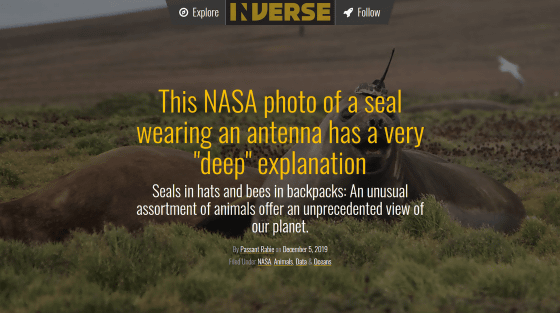NASA researchers trying to solve the mystery of the ocean by attaching an antenna to the head of the seal

Enhanced upward heat transport at deep submesoscale ocean fronts | Nature Geoscience
https://www.nature.com/articles/s41561-019-0489-1
Data with Flippers? Studying the Ocean from a Seal's Point of View – Climate Change: Vital Signs of the Planet
https://climate.nasa.gov/news/2871/data-with-flippers-studying-the-ocean-from-a-seals-point-of-view/
Seal takes ocean heat transport data to new depths
https://phys.org/news/2019-12-ocean-depths.html
This NASA photo of a seal wearing an antenna has a very 'deep' explanation | Inverse
https://www.inverse.com/article/61485-seal-antenna-photo

Oceans around the Antarctic, including the Antarctic Ocean, connect the Atlantic Ocean, the Pacific Ocean, and the Indian Ocean, and are very important points when considering the global climate system. Antarctic ocean currents are expected to play a major role in heat transport in the ocean, but heat transport in the upper and lower layers of the ocean is not yet fully understood. The currents in the Antarctic Ocean are extremely violent, stormy eddies are generated in the atmosphere, and it is difficult to investigate the Antarctic Ocean in a region far from the village.
So Siegelman decided to collect data on the Antarctic Ocean by attaching an “antenna like a hat” to the head of southern

A southern elephant seal with an antenna swam over 4,800 km during the three months of the survey period, diving 80 times a day, and swam around the sea at a depth of 500-1000 m. “Even when sleeping, seals dive into the sea and float like leaves,” Siegelman said. Some southern elephant seals swim under the ice in Antarctica, and it seems that they were able to obtain valuable data that could not be obtained by ordinary surveys.
The antenna attached to the southern elephant seal was recovered when the seal returned to the land in time for breeding or hair restoration, and the team obtained the collected data. Also, when the hair of a southern elephant seal comes off, it seems that the hair on the surface will peel off like a molting, and even if it fails to collect the antenna, it was a mechanism that can take the antenna with the replacement of the hair .

Siegelman et al. Analyzed data collected by southern elephant seals and satellite observations, and identified the location where the “underwater front” occurs, where the density of water changes abruptly due to eddies created in the sea. Mr. Siegelman points out that this front played a role of carrying heat from the deep ocean to the ocean surface, and the front in the ocean was functioning as a '
“Most modeling studies so far have shown that ocean heat moves from the surface into the ocean, but observations from southern elephant seals have shown that this is not the case.” Said Siegelman. The discovery of new heat transport systems will affect the Earth's climate model and heat balance model, as the ocean surface is warmed by the underwater front, making it difficult for the ocean to absorb heat from the atmosphere. There is a possibility.
Siegelman said, “Not accurately capturing these small fronts can underestimate the heat transported from the ocean interior to the ocean surface, resulting in an excessive amount of heat that the ocean can absorb. It may be evaluated. ' He argued that further research was needed to understand the long-term effects of underwater fronts on oceans and climate systems around the world.

Related Posts:







